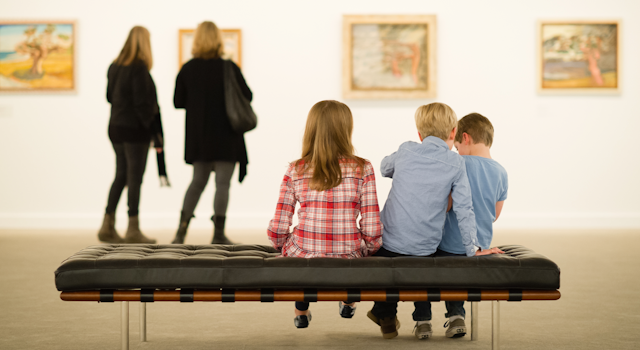Visual skills are essential for a sophisticated workforce, yet we offer so little education in the vital skills of learning to see and developing the ability to interpret and critique our image-saturated world.
In the global marketplace, the economy of the cultural industries is growing in importance, and visual expression is part of everyday communication. For Australia to compete in this marketplace, visual acuity, visual literacy and the ability to communicate visually must be recognised as an equally fundamental skill to those of language and numeracy. These can all be taught through grounding in the visual arts.
There is a growing body of international and Australian research that demonstrates a direct link between an arts-rich education from an early age and an increase in students’ confidence, their intellectual abilities across all learning areas, problem-solving skills, and general life skills.
The visual arts provide a vital cultural component and deliver on a range of important skills otherwise missing from the curriculum. They also provide a platform for addressing the important issues of our times; they build self-reflective, empowered communities; and, let’s not forget, they also bring great joy and reassurance in times of anxiety.
Future skills
As the 2016 World Economic Forum report on The Future of Jobs predicted, the top necessary skills required for the fourth industrial revolution will be complex problem-solving, critical thinking and creativity, alongside emotional intelligence and cognitive flexibility.
Read more: Fourth industrial revolution: sorting out the real from the unreal
Highly specialised, rigidly structured degree courses aimed at a specific job outcome will be redundant in this emerging environment. But degrees with a strong visual arts foundation will ensure individuals will flourish, not flounder, under the impact of disruptive technologies and when confronted by new ways of working.
Steve Jobs said he employed people at Apple with passion, particularly for problem-solving, “having a vision, and being able to articulate it so people around you can understand it, and getting a consensus on a common vision”. It’s why Jobs also said he wanted to see applicants’ drawing portfolios before he employed them.
Work in the visual arts also generates new images and develops new ideas. These have the potential for commercialisation at a time when the government is pursuing its agenda on innovation and promoting the creative industries. For instance, several of the residencies through the Australian Network for Art and Technology Synapse program have led to further research and potential commercialisation.

Ever-expanding digital platforms will also need more and more creative content, requiring that all employees in every profession have opportunities to develop these skills.
We must then ensure that the creative arts are a core component of the curriculum so that all students will become more resourceful and better equipped to successfully manage change.
As well as teaching us vital skills, the arts also enrich, enhance and transform individual lives. This is the intrinsic benefit of the arts, which also has a value to the wider community.
It’s not just about individual pleasure, though. The arts change attitudes, and by so doing they can transform society. An education in the visual arts provides students with a better chance of achieving these shifts in our collective consciousness.
Read more: Friday essay: can art really make a difference?
Embedding arts at universities
Studying the visual arts provides the hothouse environment that brings the instrumental and intrinsic benefits of the arts into unison. It becomes a forum in which to explore new possibilities and critique existing presumptions and preconceptions about art and life.
Our challenge is to find ways of integrating the visual arts into the core curriculum and at the heart of the student experience. This includes an object-based learning approach to teaching (for instance, including study of artworks and artefacts).
Internships, courses that integrate the arts within other disciplines, and collaborative projects designed for students across discipline areas are just some examples of strategies already employed at universities.
That is our challenge, to work collaboratively across academic disciplines to re-imagine the role of the visual arts in the 21st century university.
This article is an edited extract from a keynote address to the Australian Council of University Art & Design Schools (ACUADS) annual conference being held in Perth on September 27-28.

